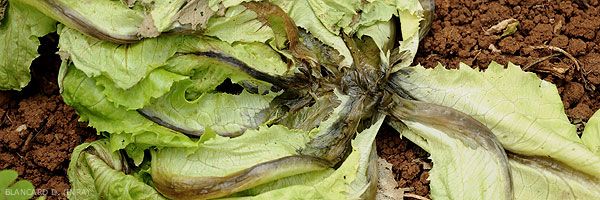
Bacterial diseases
About 250 species, biovars and pathovars, representing 17 bacterial genera have been identified in bacteria. Four genera seriously affect lettuce: Pseudomonas , Xanthomonas , Pectobacterium and Rhizomonas . The Pseudomonas are divided into two entities: the " fluorescent " ( P. cichorii , Pseudomonas marginalis pv. Marginalis ) and " non-fluorescent " depending on the formation or not, on the middle of King, a diffusible fluorescent pigment and under UV light. Among the Pectobacterium (anc. Erwinia ), mention will be made essentially of Pectobacterium carotovorum subsp. carotovorum which is harmful to lettuce, both during cultivation and during transport and storage.
Bacteria attached to salads are relatively autonomous, they can parasitize them or live as a saprophyte in the phyllosphere ( life epiphytic ) and rhizosphere. They are found on other plants, in the soil, in organic matter, on many plant debris on which they are easily preserved. Their wall gives them a certain resistance.
All organs of the plant can be affected:
- leaves ( Pseudomonas cichorii , Xanthomonas campestris pv. vitians , Pectobacterium carotovorum subsp. carotovorum ) ;
- lpivot and stem ( Pectobacterium carotovorum subsp. Carotovorum , Pseudomonas marginalis pv. Marginal ...);
- the roots ( Rhizomonas suberifaciens );
- the vascular system ( Pectobacterium carotovorum subsp. carotovorum in some cases).
Their penetration into salads is carried out in several ways:
- through natural openings such as stomata and hydatodes ( Pseudomonas cichorii , Xanthomonas campestris pv. vitians );
- through various injuries accidental (hail or insect damage, etc.) or caused by cultural operations such as those occurring during harvesting ( Pectobacterium carotovorum subsp. carotovorum , Pseudomonas marginalis pv. marginalis ).
Once in the tissues, they first develop between plant cells that they kill quite quickly thanks to different enzymes. This is especially the case with Pectobacterium spp. but also Pseudomonas marginalis var. marginalis and Pseudomonas viridiflava , which, thanks to their pectinolytic enzymes , are responsible for soft rots. They sometimes produce toxins inducing the formation of a yellow halo around the alterations. This does not seem to be the case with salads. Colonized tissues harbor large amounts of bacteria which can be disseminated in different ways:
- following rains generating splashing drops of water or by running water;
- through contaminated seeds ( Xanthomonas campestris pv. vitians );
- by man and his tools;
- by certain animals and insects.
The water present on the plants or soaking the soil is in the first place the factor conditioning bacterial epidemics. It can come from rains, irrigation, morning dews ... It is essential for the good progress of contaminations, infection and the dispersion of bacteria.
The temperature has less influence on the development of bacteria attacking salads.
Bacteria attached to salads are relatively autonomous, they can parasitize them or live as a saprophyte in the phyllosphere ( life epiphytic ) and rhizosphere. They are found on other plants, in the soil, in organic matter, on many plant debris on which they are easily preserved. Their wall gives them a certain resistance.
All organs of the plant can be affected:
- leaves ( Pseudomonas cichorii , Xanthomonas campestris pv. vitians , Pectobacterium carotovorum subsp. carotovorum ) ;
- lpivot and stem ( Pectobacterium carotovorum subsp. Carotovorum , Pseudomonas marginalis pv. Marginal ...);
- the roots ( Rhizomonas suberifaciens );
- the vascular system ( Pectobacterium carotovorum subsp. carotovorum in some cases).
Their penetration into salads is carried out in several ways:
- through natural openings such as stomata and hydatodes ( Pseudomonas cichorii , Xanthomonas campestris pv. vitians );
- through various injuries accidental (hail or insect damage, etc.) or caused by cultural operations such as those occurring during harvesting ( Pectobacterium carotovorum subsp. carotovorum , Pseudomonas marginalis pv. marginalis ).
Once in the tissues, they first develop between plant cells that they kill quite quickly thanks to different enzymes. This is especially the case with Pectobacterium spp. but also Pseudomonas marginalis var. marginalis and Pseudomonas viridiflava , which, thanks to their pectinolytic enzymes , are responsible for soft rots. They sometimes produce toxins inducing the formation of a yellow halo around the alterations. This does not seem to be the case with salads. Colonized tissues harbor large amounts of bacteria which can be disseminated in different ways:
- following rains generating splashing drops of water or by running water;
- through contaminated seeds ( Xanthomonas campestris pv. vitians );
- by man and his tools;
- by certain animals and insects.
The water present on the plants or soaking the soil is in the first place the factor conditioning bacterial epidemics. It can come from rains, irrigation, morning dews ... It is essential for the good progress of contaminations, infection and the dispersion of bacteria.
The temperature has less influence on the development of bacteria attacking salads.





